You close your eyes and see your beloved dog, walking along beside you in perfect harmony, both of you enjoying a sunny afternoon stroll through the park with all the other dogs and owners out.
You open your eyes, sigh, and grab the leash while your pup screams in excitement, jumping all over you as you clip on the leash and head out to get the necessary chore of dog walking done.
Your shoulder is already sore in anticipation of the pulling you know will happen, as your dog excitedly encounters other dogs, people, and vehicles, and lunges towards them.
Maybe, just maybe, it will get better as he matures.
Walking with your dog can be a pleasurable activity, but it takes some work. Leash manners aren’t likely to appear as a result of wishful thinking and growing up.
Some equipment can make it easier, though, and help prevent the development of bad habits while you work on the training.
Equipment to Help with Loose Leash Walking
There are plenty of collars and harnesses that promise to make walking your dog easier. Some actually work, at least in the short term.
Many of those, like prong collars, command collars, and electronic collars, work by causing pain, and are not something I can recommend.
So, what equipment helps control your dog’s pulling without causing pain?
Our article on the best dog collars and harnesses for training takes you through our top picks for all these designs, but in short:
- Y-shaped harnesses with a front clip. These harnesses have a place to clip the leash in the front. When the dog pulls, the front clip will cause him to turn, prevtning pulling. These are an especially good option if you combine it with a leash clipped to a regular collar. (Top Pick: Freedom Harness)
- Regular flat collar. You can also work on loose leash walking with a standard flat collar. While a flat collar can usually handle a bit of pulling, heavy, strong pullers risk throat damage with a flat collar.
- Y-shaped harness with a clip on the back. A harness with a back clip can work just fine for training too. This design won’t prevent your dog from pulling – in fact, they’ll be able to throw their full weight into pulling. However, if you’re working on loose leash training this shouldn’t be a huge issue. Plus, it’s usually easier for owners since your dog won’t constantly be stepping over the leash. (Top Pick: RuffWear Front Range Harness).
- Head halter. Head halters allow you to steer your dog’s head, and therefore controlling your dog’s direction of movement. However, you’ll need to avoid jerking motions which could seriously hurt. It’ll also take your dog some time to adapt to this tool through desensitization.
- Long line. A long line that’s at least 15 feet long can help reduce pulling – but don’t use a flexi-lead. Flexi leads (aka retractable leashes) teach your dog that pulling is the only way to move forward. Long lines help because most dogs won’t pull if they have more space to move and sniff.
- Standard leash. While long lines can be super helpful, they won’t be appropriate in all situations, so you’ll need a standard-sized leash too. However, we’d recommend opting for a dual handle or slightly longer leash for dogs who pull, as even an extra foot or two of length can be helpful.
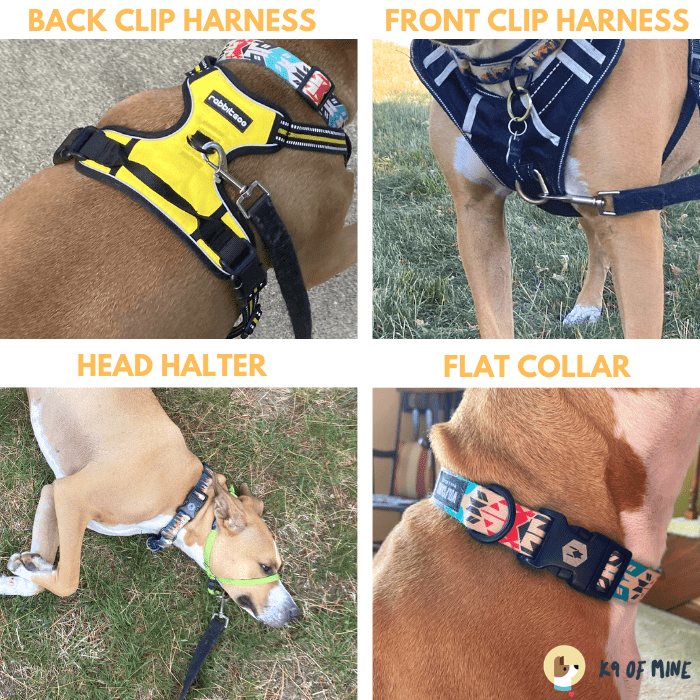
Some other harnesses work by impinging shoulder movement, which can lead to long-term joint issues if relied on too much. In the long term, I like to see people moving away from these options.
Equipment is Only a Band-Aid
Many of the no-pull tools listed above work great as triage” options, but they don’t actually teach your dog how to walk nicely on leash.
Some owners think that, in order to solve their dog’s pulling problem, all they need is the right collar or harness and the issue will be solved.
However, the best (and only reliable) way to stop your dog from pulling is by training your dog to walk politely on the leash. While this is certainly a bit more effort than throwing on a piece of equipment and calling it a day, taking the time to work with your dog is essential.
Nearly all no-pull harnesses and collars on the market have some kind of drawback or risk associated with long-term use. Tools will never be the solution to the pulling problem – but rather, an aid while you work on loose leash training.
What Exactly Is “Loose Leash” Walking?
Some people have different ideas when it comes to defining loose leash walking.
There are a few different options:
- Option #1: Your dog can walk ahead of you, so long as the leash is slack
- Option #2: Your dog walks beside you, in a unstructured, loose heel
How you want to define loose leash walking for yourself and your dog is really up to you. There are plenty of people in both camps.
Many folks don’t mind letting their dog walk in front of them as long as there is no tension on the leash. It can be easier to see what your dog is up to when they are in front of you, and many owners prefer this.
Other owners expect their dog to stay within a foot or two of their left leg during a walk, unless given a release command to go sniff and explore.
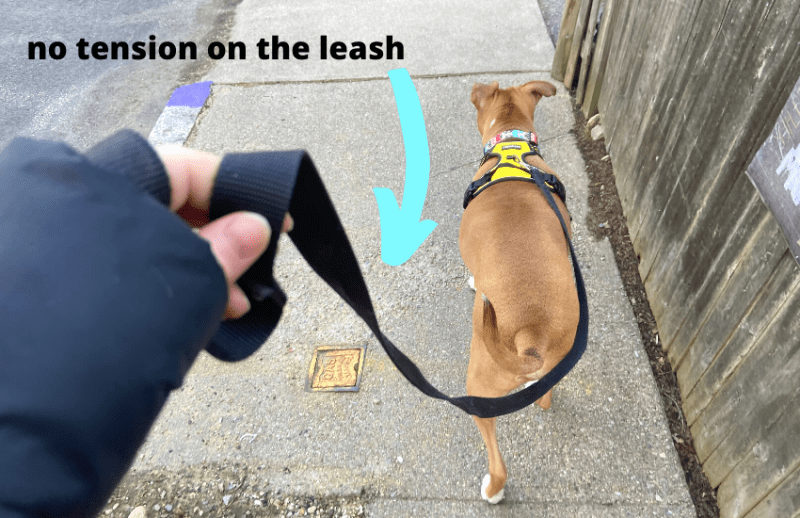
Personally, I’m in the first camp. Walks are my dog’s time, and he’s allowed to sniff whatever he wants as long as he keeps the leash slack. Sniffing is extremely self-soothing for dogs and burns a lot of excess mental energy, so in my opinion, it seems foolish to ever deny a dog that opportunity.
But, to each his own! Choose a method that will work for you and your dog.
It should be noted that a structured heel is very different than either of the options listed above.
In a structured heel, your dog stays right beside, with their nose directly against your leg. This kind of formal heel is very stressful for a dog to maintain, and it’s not very practical for a standard walk.
A proper heel can still be really useful when navigating tight streets in a city center or for short-term use when passing strangers on a sidewalk. But you should never keep your dog in a formal heel for their entire walk. It’s no fun for your dog at all!
The training games detailed below can be used when working on either form of loose leash walking. Just keep in mind we are not defining loose leash walking as a strict, formal heel.
Starting Indoors & Managing Expectations
Taking a calm and relaxed walk in the park among other dogs may be the end goal, but it isn’t the best place to start. You should begin in your own backyard, or even inside.
The outdoors is very stimulating for dogs. Your dog spends most of his day lounging about in your home, which doesn’t change much day to day.
But the outdoors is full of exciting sights, smells, and sounds. Dogs rely on smell as their primary sense. So while we might not notice anything particularly exciting about our boring old neighborhood, your dog is sniffing scents left behind by every person and animal that has passed by!
Your dog isn’t stubborn – he’s just struggling
There is a common misconception that dogs who pull on the leash are being “bossy,” “stubborn,” or trying to “be the apha” (be sure to check out our alpha myth debunked article for a better understanding of why this mindset is such a mistake).
None of this is true!
Your dog is not being stubborn or difficult – he is simply overwhelmed by the sights and scents of the outdoors and has a hard time focusing on you when there is so much going on around him.
As I once heard a trainer say – your dog is not giving you a hard time, they are having a hard time.
When I first started taking my rescue dog Remy on walks, he would freeze every few steps and it would take us an hour to do what normally was a 20 minute walk. I initially was pretty annoyed.
I would think to myself: Why isn’t he listening to me? He must think he can do whatever he wants and doesn’t respect me.
I now recognize a lot of that frustration was due to me projecting my own insecurities and fears about adopting a new, somewhat difficult rescue pitbull mix.
It’s clear to me now, as I’ve learned more about dog behavior, that Remy was never socialized as a puppy. In fact, he probably spent most of his early life chained in a yard with little to no access to the outside world.
Because of this, going on even a short walk around my boring neighborhood was incredibly overwhelming. His constant freezing was due to his anxiety and nervousness, not because he was stubborn or being a brat.
For any new skill, start in a low-stress environment
So how do you compete with a stimulating environment that overwhelms your dog? You practice the skill you are looking to hone in a less stimulating environment.
Just as you would never take a child to Disney World, put a desk on Main Street USA, and then ask them to sit down and take a math test, you shouldn’t take a dog into the outdoors and expect them to focus on you.
It’s not purposeful disobedience, just as a child may not necessarily refuse to take the math test – it will just be incredibly hard for them to do so when there is so much excitement and stimulation happening all around them.
Here’s how your training process should go when working on these loose leash games:
- Level 1: Start out practicing indoors around the house
- Level 2: Take your training games to a familiar, relatively calm outdoor setting, like your driveway or back yard.
- Level 3: Begin to practice your loose leash walking skills on a single street outside of your home
- Level 4: Continue your loose leash walking games while going on a standard neighborhood walk
- Level 5: For gold level status, burn in these skills by practicing in very stimulating environments like around a dog park, on hiking trails, and new locations your dog has never been to before.
It should also be noted it’s not a huge deal if you never get to level 5. Think about what skills you actually need your dog to have to be happy. Some owners want to be able to have a relaxing walk, but don’t mind switching to a front-clip harness in more stimulating environments.
Your dog won’t always walk perfectly on leash, and that’s totally normal
Also keep in mind that there are other factors that will affect your dog’s ability to stay calm. For example, my dog Remy can do a pretty decent loose leash walk when we’re trotting around the neighborhood. However, there are a few things that will cause him to pull excessively, such as:
- Inclement weather (like rain or snow)
- Other dogs up ahead
- Joggers running by us
Remy is a high arousal dog, which means he gets overly excited at the drop of a hat. While it can be frustrating to have Remy suddenly jerk me all over when new triggers or stimuli push him over his threshold, I try not to get frustrated. It’s not his fault.
While reaching Level 5 is certainly a great goal to strive for, it’s important to be realistic about what your dog can handle, where his threshold is, and to have realistic expectations about what to expect from him depending on where you are in your training.
Loose Leash Walking Games: Teaching Your Dog to Walk Politely on Leash
We’ll outline several different training options for teaching your dog to stop pulling on walks. If you’re more of a visual learner, make sure to check out our YouTube video covering examples of the games detailed here. And don’t forget to like and subscribe to our YouTube channel!
Strategy #1: The Silky Leash Technique
The Silky Leash Technique was developed by Grisha Stewart. It teaches the dog to yield to small amounts of pressure on the leash.
Start inside, in a boring room, and have some treats ready.
You can use a clicker if you are used to using one, or simply mark the right behavior with a short word, such as “yes!”
Clip the leash onto your dog’s collar, and wait until things are calm. Apply a slight amount of pressure on the leash to one side, and wait for your pup to yield a bit to that pressure. Your pup might actually move towards the leash pressure, or just shift his weight a bit. Take whatever you get!
Mark the moment, and give a treat. Wash, rinse, and repeat until you can see the dog respond readily to very slight leash pressure while inside, then start working on it in a familiar place outside.
Check out the video of Kayla working on silky leash training with Barley below.
Be sure to gradually increase distractions rather than taking your dog straight from the basement training room to the dog park! Move from the house, to the back yard, to a quiet side street, and finally work around the entire neighborhood.
Now, whenever the dog is pulling, it becomes a cue for the dog to give in to the pressure!
Strategy #2: 1-2-3 Walking
1-2-3 walking is one of the Pattern Games developed by Leslie McDevitt. This technique works really well to help the dog process the environment and learn to handle distractions.
This game is really simple:
- Have some treats in your pocket or treat pouch (but don’t lure your dog around with the treats).
- As you’re walking, count out loud, “One, two, three.”
- Right when you say “three”, give your pup a treat. Start out just delivering treats right to your pup’s mouth until he gets it that treats come when you say three.
- Next, start to deliver the treat right next to the seam of your pants at head height for your dogs. Keep your hand touching your leg, so that you’re delivering the treat nice and close. This helps train your dog to stay super close to you.
Keep walking around, counting out loud, and ignore anyone giving you funny looks. Like all leash walking techniques, start playing this game somewhere relatively boring and safe.
Once you have established the game, your dog should understand that when you start counting, treats are coming, and will be there when you say “three,” and you can use this when you go to someplace more exciting. Just make sure you have plenty of treats ready for training!
Strategy #3: Red Light, Green Light
With this technique, you’ll basically begin playing a game of red light, green light with your dog!
The idea is that you freeze and the walk completely stops when your dog puts any tension on the leash.
Many owners accidentally reinforce pulling by allowing the dog to pull them towards whatever the dog is trying to access (whether that’s another dog, a particularly smelly fire hydrant, or a desirable plot of grass).
When your dog learns that pulling allows them to access these desirable items, you are reinforcing that pulling does in fact work!
Here’s how it plays out, step by step:
- As soon as your dog begins to pull, freeze and stop moving. If there’s tension on the leash, the walk halts.
- Call your dog over to you and encourage him to move back towards you. You can do this by calling him with an excited voice or making a kissy sound.
- Wait for your dog to take a step backwards or turn around to give you focus.
- Once there is slack on the leash, you can keep walking.
If you’re looking for a loose leash walk that’s closer to a relaxed heel, you can modify this slightly.
Freeze when there’s tension on the leash and then call your dog to your side, either by simply patting your leg or by asking for a hand target.
Once your dog is back in the desired position beside your leg, you can click and treat and continue the walk.
For this game, you don’t necessarily need to use treats since continuing the walk can work as its own reward, but I find that using treats is helpful for getting my dog to return and maintain a loose heel position.
Strategy #4: Flip it and Reverse it
This game is a modification of the red light, green light game described above.
In this version, instead of freezing and waiting for your dog to loosen up on the leash, you’ll turn around and go the other way, encouraging your dog to follow you.
This now places your dog behind you. As your dog comes forward and approaches your side, click and treat.
This is an easy way to create opportunities where your dog is in a loose heel walking position, which you can reward him for.
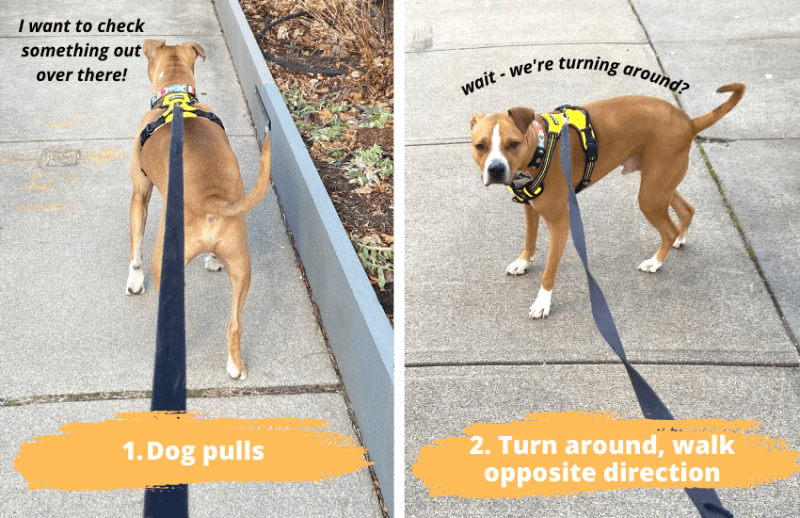
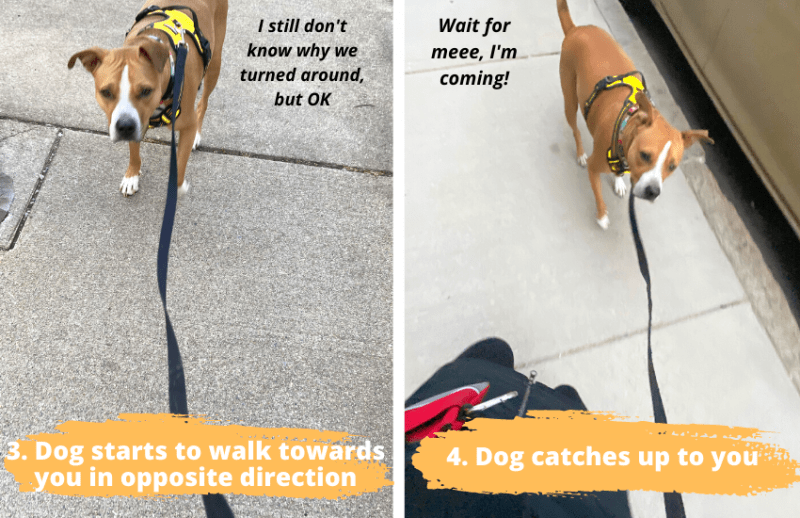
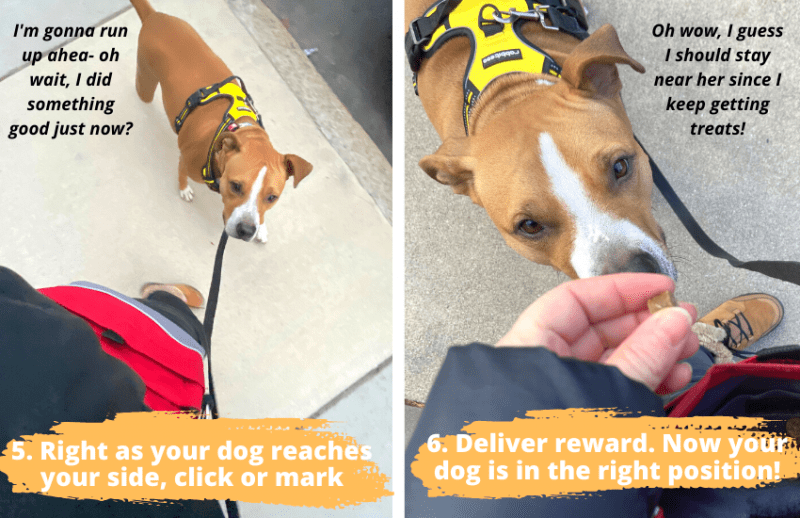
Strategy #5: Rewarding “Check-Ins”
Another exercise for working on loose leash walking involved rewarding your dog for “check-ins” – aka, when they choose to look up and focus on you.
This game is especially helpful when you’re looking to establish a loose heel.
Our favorite check-in / focus word is “look at me”. When I say this to Remy, he knows that he needs to look up at me, and then he’ll get a treat.
Here’s how to teach a check-in command with ease:
- Choose a focus word or phrase such as “look at me”
- Click and reward when your dog looks up at you after you say the focus phrase. Deliver the treat to your leg position.
- Rinse and repeat until your dog can reliably look up and refocus on you when requested.
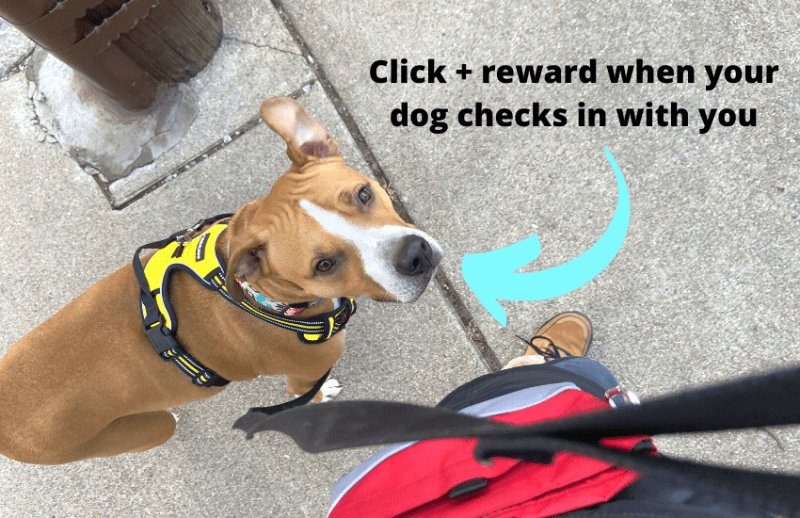
If your dog is having trouble with this, try taking a piece of kibble and holding it up to your eyes. As soon as your dog makes eye contact, click and reward with the kibble.
Having a solid focus command is a terrific skill for refocusing an over-aroused dog and working on things like reactivity, but it works great for building loose leash walking skills too.
This is because your dog can’t really look at you without being beside you.
Or, if they are ahead of you, they will have to stop and turn around to look at you, giving you a chance to step forward and reposition them to be standing beside you.
Now that your dog is in the proper position with a loose leash, take a few steps forward and immediately click and reward again, while your dog is still beside you. This is a great way to build a loose heel and encourage your dog to walk alongside you.
Setting Up Practice Scenarios
After you’ve done some of the loose leash walking training games described above, set something out that your dog wants, like a toy, or bowl with a few low-level treats (you want it to be enticing, but not too difficult)!
Be ready to use your strategies, and start about 50 feet away. Start to walk towards the “bait” and keep practicing your skills. Make sure you don’t give your pup the opportunity to get to the object without you!
When you get close without your pup pulling, give your dog permission to get the toy or treats through a release world (like “free” or “go for it”).
If at any point, the dog makes a serious attempt to get to the toy or treats, stand still, don’t move, and wait for the dog to give up the attempt and come at least a little bit back to you before starting back.
Work up to using higher level treats or toys, and increase the distance you expect your pup to walk nicely before getting his toy or treats.
Setting up practice scenarios is one of the biggest keys to success in loose-leash walking.
Loose Leash Troubleshooting: Why Isn’t This Working?
Running into issues with loose leash training? Is your dog still pulling all the time? Here are some things to try for better results:
- Try higher value treats. Some dogs might need more motivating treats. If you’re using kibble for training, try some higher-value treats like hot dogs.
- Practice in less stimulating environments. If your dog is having trouble keeping the leash loose on a walk around the neighborhood, so back to practicing indoors and in your yard.
- Avoid your dog’s triggers. Some dogs will have certain triggers that make it really difficult for them to not pull or lunge. Dogs with a high prey drive find it nearly impossible to resist squirrels, and reactive dogs might not be able to handle passing other dogs. Know your dog’s triggers and avoid them!
How to Stop Using Treats All the Time
“But he’ll get fat, and I don’t want to give him treats forever. My hands get slimy, and what if I forget?” I hear you say.
I totally get it!
You can use your dog’s daily food ration to start with, though you may need better treats when you first start working in the real world. My personal favorite is chopped-up hot dogs, but there’s a lot of great treats for training out there.
Just because we are using treats to get the process started, doesn’t mean you’ll have to always use them. However, you should continue to use treats intermittently to maintain the behavior – think of it like a reminder.
You like payday and your dog does, too!
Loose leash walking is a skill like any other – it needs to be maintained and refreshed from time to time. Once your dog is reliably loose leash walking, try just bringing treats with you every other walk, and then eventually on just one walk a week.
Once your dog understands how to walk nicely, you can use life rewards, like going to the park or investigating an especially enticing garbage can.
However, don’t even think about giving up on treats until your dog’s loose leash walking skills are really polished.
Starting the Walk and Getting Out the Door
Speaking of life rewards, taking a walk is often very rewarding for your pup. Remember that scenario at the beginning, with the dog screaming and jumping around while you put on the leash?
Once you’ve started to make headway on walking nicely, it is time to address any problematic pre-walk behavior. It’s not unusual for dogs to get psyched up for a walk, but the adventure can’t begin until they’ve calmed down.
Choose a day and time when you can wait your dog out, and don’t expect to get perfect behavior the first time out. But once you’ve started this process, it’s important to be consistent and not continue to allow the crazy behavior.
- Pick up the leash, and watch your pup go crazy.
- Put your leash down, and wait until your pup gets bored and settles down.
- Pick up the leash again, and watch your dog go crazy again.
- Repeat the process until your dog can settle down while you’re holding the leash. Only then can you put the leash on.
This helps put your dog into a calmer frame of mind before your walk and prevents you from rewarding him for his crazy pre-walk shenanigans.
Having a bit of control before the walk even starts, sets you up to have better control once you are actually on your walk.
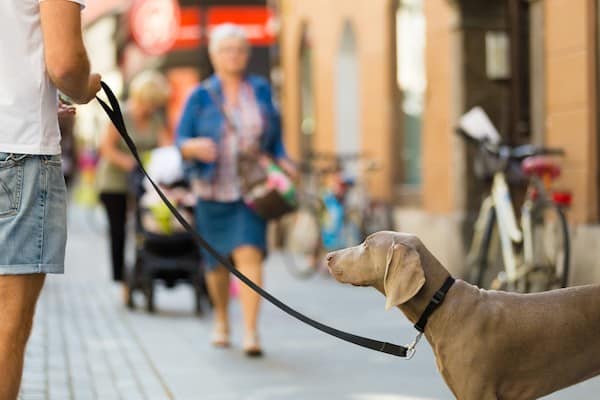
Why Does my Dog Pull on Leash?
So why do dogs pull on leash, anyway?
Because it works!
Your dog pulls to get to something he is interested in. If he succeeds, he learns that pulling works.
Preventing your dog from being successful at pulling is a key component to helping your pup have good leash manners.
The fact of the matter is, your dog also probably just walks faster than you do! Four legs tend to be quicker than two.
Pair that with his super-sniffer nose and the excitement of a walk, and no wonder we’re all being dragged down the street!
How Else Can I Exercise My Pup?
You might notice that your walks are a bit shorter while you’re working on loose leash walking.
Don’t forget that walks aren’t the only way to exercise your dog. We’ve already outlined 22 games to play with your dog – don’t forget to use them!
While you’re working on your loose leash walking, plan on helping your dog exercise in other ways. Keep walking on leash to a minimum when you aren’t actively training it.
It’s easy to get frustrated when you overdo a new training task, so in many cases, less is more!
To burn off some of that excess energy, try:
- Retrieving games
- Hide and seek
- Practice training recalls (aka how to come when called)
- Create a nosework scavenger hunt by hiding treats or toys around the yard or home.
Don’t forget, if you don’t have access to a yard, you’ll still need to walk your pup outside for bathroom purposes.
You’ll really want to try incorporating other ways to exercise your pup outside of walking, when you can. Working on your loose leash walking skills after your pup has done some other exercise can make performing those skills a bit easier since your dog will be in a more relaxed state after burning off some mental and physical energy.
It’s important to remember that if you let your pooch drag you outside to go potty one day, he’s just learned that pulling can get him what he wants.
This can threaten your loose-leash training program if you take frequent walks that you don’t use as training practice.
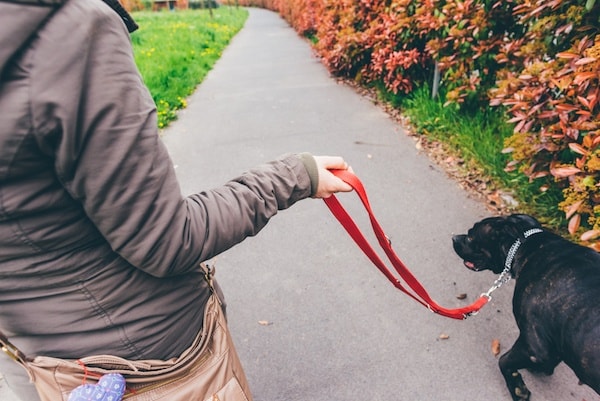
Kayla here!
If this feels daunting, here’s what I did to teach Barley. We lived in an apartment and I was busy. I couldn’t always do a training session when we clipped on the leash. Instead of always trying to treat walks as a training session, I only worked on loose leash walking if Barley’s leash was attached to his flat buckle collar. If I knew I didn’t have the time (or mental energy) for a training session, I clipped the leash to his Front Range Harness.
He quickly learned that the collar meant training time, while the harness was sniffing time. A year later, I still use his harness if we’re going on a relaxed walk, and his collar if I want him in a nice, loose leash walk the whole way.
Teaching your dog using this method is a great compromise for busy families that need to take frequent leashed walks.
– Kayla Fratt [Certified Dog Behavior Consultant]
Loose leash walking takes practice, but with some consistency, you can have a walking partner you enjoy exploring and exercising with.
Helping your dog figure out how to walk nicely with the games listed above works with many dogs, but if you have a dog that is fearful or aggressive, you may need the help of a trainer, preferably one who is versed in Leslie McDevitt’s Control Unleashed program, or Grisha Stewart’s BAT (Behavior Adjustment Training) program.
These programs use positive reinforcement to help you figure out how to develop a cooperative relationship based on trust, while helping the dog process and understand the environment as not being something to be feared or reacted to.
So go, get started and let us know how it goes! We love hearing back from our readers about how their training goes, so be sure to add your own loose leash experience in the comments below!
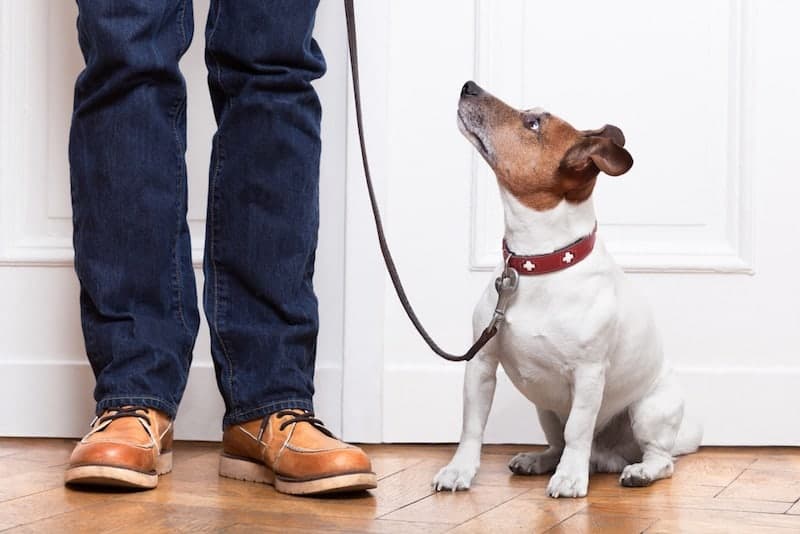




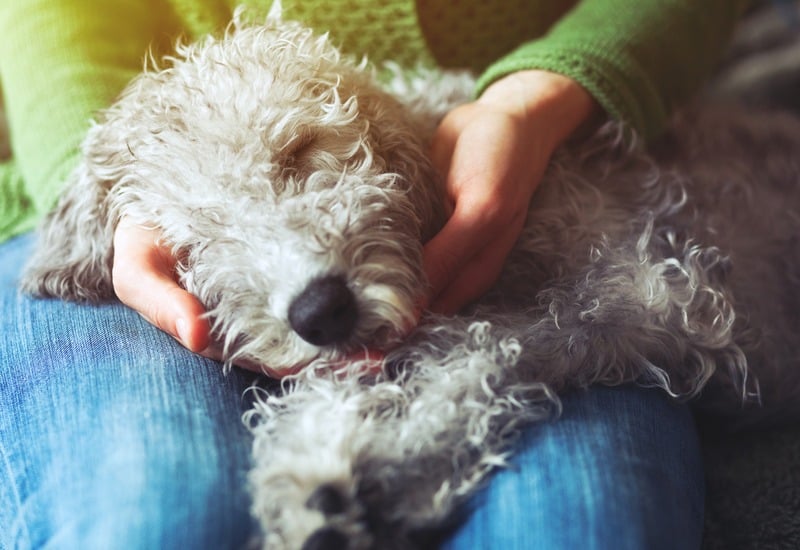
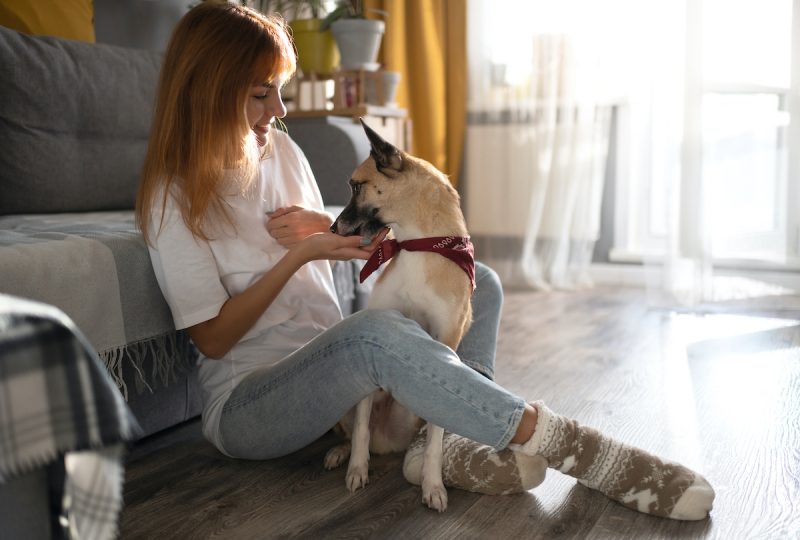

Leave a Comment